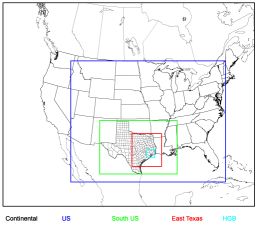Introduction to Air Quality Modeling: Meteorological Modeling
Meteorological models are used to simulate meteorological conditions, such as wind, solar radiation, humidity, and air temperature, that affect air pollutant concentrations.
Meteorological modeling is performed retrospectively to simulate the meteorological conditions (wind, temperature, vertical mixing, etc.) from past air pollution episodes. The numerical simulations are used as input to the photochemical model in the agency's air quality modeling process. TCEQ currently uses the Weather Research and Forecasting (WRF) Model .
The Role of a Meteorological Model in Air Quality Modeling
In order for a photochemical model to properly simulate pollutant formation, it is crucial that the meteorological conditions be realistically modeled. The TCEQ uses state-of-the-science, four-dimensional computer models that incorporate atmospheric physical laws and measured observations to predict weather conditions over time and space. The meteorological model output is then used as input by the photochemical model to predict pollutant concentrations.
How Does a Meteorological Model Work?
The basic structure of a meteorological model uses universal laws of atmospheric physics as well as empirical relationships to calculate wind flow, temperature, humidity, vertical air mixing, and other parameters in time and space. The model predicts these parameters in three-dimensional grid boxes stacked horizontally and vertically at equidistant points over the domain(s) of interest.

Example of Nested Modeling Domains
While the focus is on a metropolitan area, the meteorological model needs forcing from large weather patterns to properly simulate conditions at the local scale. This is accomplished by running the model on multiple nested domains, from continental to multi-county size. Each successively smaller domain receives feedback from the larger domains to determine background flow and boundary conditions, thus producing local atmospheric conditions based on large-scale features.
During the model run, predicted parameters are blended with observations through a process called Four-Dimensional Data Assimilation (FDDA) or nudging. By assimilating ambient data, the meteorological model is continuously nudged toward reality. The resulting model output closely matches the monitored meteorological values while producing meteorological parameters over the entire domain that are valid according to atmospheric physics laws.
Processing Observed Meteorological Data
TCEQ staff acquire surface and upper air meteorological data about the modeling domain from sources such as:
- TCEQ monitors
- National Oceanic & Atmospheric Administration (NOAA)
- National Weather Service (NWS)
- National Center for Atmospheric Research (NCAR)
- State agencies, universities, metropolitan areas, and industries
After the data are collected and quality assured for errors, they are used for model validation or observational nudging.
Preparing Meteorological Model Outputs for the Photochemical Model
After careful quality assurance of the output variables from the meteorological model, they are then processed into a format that can be input into the photochemical model.
Major Meteorological Models
The following are major meteorological models used by the air quality modeling community:
